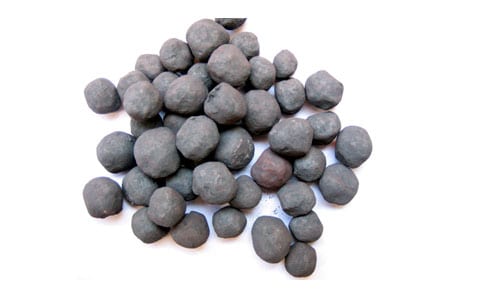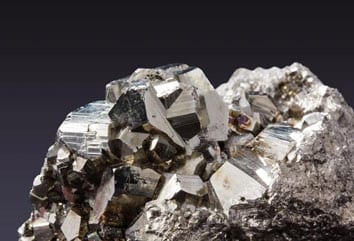ເລືອກພາສາ:
Iron ore is the fourth most common element in the earth’s crust. Iron is essential to steel manufacturing and, ເພາະສະນັ້ນຈຶ່ງ, an essential material for global economic development. ທາດເຫຼັກໄດ້ຖືກນໍາໃຊ້ຢ່າງກວ້າງຂວາງໃນການກໍ່ສ້າງແລະການຜະລິດຂອງຍານພາຫະນະ. Most iron ore resources are composed of metamorphosed banded iron formations (BIF), ທີ່ທາດເຫຼັກໄດ້ຖືກພົບເຫັນທົ່ວໄປໃນຮູບແບບຂອງການຜຸພັງໄດ້, hydroxides, ແລະ, to a lesser extent, carbonates.
The chemical composition of iron ores is apparent to be wide, especially for Fe content and associated gangue minerals. Major iron minerals associated with most iron ores are hematite, goethite, limonite, and magnetite. ການປົນເປື້ອນຕົ້ນຕໍໃນແຮ່ເຫຼັກແມ່ນ SiO2 ແລະ Al2O3. The typical silica and alumina-bearing minerals present in iron ores are quartz, kaolinite, gibbsite, ເຊື້ອສາຍ, and corundum. ຂອງເຫຼົ່ານີ້, it is often observed that quartz is the main silica-bearing mineral, and kaolinite and gibbsite are the two main alumina-bearing minerals.


Iron ore extraction is mainly performed through open pit mining operations, ຜົນອອກມາໃນການຜະລິດແຮ່ທີ່ສໍາຄັນ. ລະບົບທາດເຫຼັກຜະລິດແຮ່ປົກກະຕິແລ້ວມີສາມຂັ້ນຕອນ: ຂຸດຄົ້ນບໍ່ແຮ່, ການປະມວນຜົນ, and pelletizing activities. Processing ensures that an adequate iron grade and chemistry are achieved prior to the pelletizing stage. ການປະມວນຜົນລວມເຖິງບົດ, ການຈັດປະເພດ, ໂຮງສີ, and concentration, with the aim of increasing the iron content while reducing the amount of gangue minerals. Each mineral deposit has its own unique characteristics with respect to iron and gangue-bearing minerals, and therefore, it requires a different concentration technique.
Magnetic separation is typically used in high-grade iron ore beneficiation, where the dominant iron minerals are ferro and paramagnetic. ປຽກແລະແຫ້ງຕ່ໍາຫຼາຍແຍກຕ່າງຫາກສະນະແມ່ເຫຼັກ (LIMS) techniques are used to process ores with strong magnetic properties, such as magnetite, while wet high-intensity magnetic separation is used to separate the Fe-bearing minerals with weak magnetic properties, such as hematite, from gangue minerals. Iron ores such as goethite and limonite are commonly found in tailings and do not separate very well by either technique.

Flotation ຖືກນໍາໃຊ້ເພື່ອຫຼຸດຜ່ອນເນື້ອໃນຂອງ impurities ໃນແຮ່ເຫຼັກຕ່ໍາຊັ້ນໃນ. ແຮ່ເຫຼັກສາມາດໄດ້ຮັບການເພື່ອແນໃສ່ບໍ່ວ່າຈະໂດຍ flotation Anionic ໂດຍກົງຂອງທາດເຫຼັກຜຸພັງຫຼື flotation cationic ຂອງ silica ໄດ້ຢ່າງສິ້ນເຊີງ; ຢ່າງໃດກໍຕາມ, reverse cationic flotation remains the most popular flotation route used in the iron industry. The use of flotation is limited by the cost of reagents, the presence of silica and alumina-rich slimes, and the presence of carbonate minerals. ຍິ່ງໄປກວ່ານັ້ນ, flotation requires wastewater treatment and the use of downstream dewatering for dry final applications.
The use of flotation for the concentration of iron also involves desliming, as floating in the presence of fines results in decreased efficiency and high reagent costs. Desliming ເປັນສິ່ງສໍາຄັນໂດຍສະເພາະສໍາລັບການໂຍກຍ້າຍຂອງ alumina ເປັນແຍກຕ່າງຫາກຂອງ gibbsite ຈາກ hematite ຫຼື goethite ໂດຍຕົວແທນດ້ານການເຄື່ອນໄຫວໃດຫນຶ່ງແມ່ນມີຄວາມຫຍຸ້ງຍາກ. Most alumina-bearing minerals occur in the finer size range (<20ຫນຶ່ງ), ອະນຸຍາດໃຫ້ສໍາລັບການໂຍກຍ້າຍຂອງຕົນໂດຍຜ່ານ desliming. ໂດຍລວມ, ເປັນຄວາມເຂັ້ມຂຸ້ນສູງຂອງການປັບ ໃໝ (<20ຫນຶ່ງ) ແລະ alumina ເພີ່ມປະລິມານເກັບ ກຳ ຂໍ້ມູນທີ່ ຈຳ ເປັນແລະຫຼຸດລົງໃນການເລືອກຢ່າງຫຼວງຫຼາຍ. ດັ່ງນັ້ນ, desliming increases flotation efficiency but results in a large volume of tailings and in loss of iron to the tailings stream.
ການປຸງແຕ່ງແຮ່ເຫຼັກແຫ້ງເຮັດໃຫ້ມີໂອກາດທີ່ຈະ ກຳ ຈັດຄ່າໃຊ້ຈ່າຍແລະການຜະລິດຫາງປຽກປຽກຕິດພັນກັບການ ໝູນ ວຽນແລະວົງຈອນແຍກແມ່ເຫຼັກປຽກ. STET has evaluated several iron ore tailings and run-of-mine ore samples at bench scale (ຂະ ໜາດ ຄວາມເປັນໄປໄດ້). ມີການສັງເກດການເຄື່ອນໄຫວທີ່ ສຳ ຄັນຂອງທາດເຫຼັກແລະຊິລິໂຄນ, ມີຕົວຢ່າງທີ່ໄດ້ສະແດງຢູ່ໃນຕາຕະລາງຂ້າງລຸ່ມນີ້.

ຜົນໄດ້ຮັບຂອງການສຶກສານີ້ສະແດງໃຫ້ເຫັນວ່າຖືກປັບໄຫມແຮ່ເຫຼັກຕ່ໍາເກຣດສາມາດໄດ້ຮັບການຍົກລະດັບໂດຍສະເລ່ຍຂອງແຍກສາຍແອວ stet tribo, electrostatic. ອີງໃສ່ປະສົບການຂອງ STET, ການຟື້ນຕົວຂອງຜະລິດຕະພັນແລະ / ຫຼືຊັ້ນທີ່ສໍາຄັນຈະປັບປຸງໃນການປະມວນຜົນຂະຫນາດທົດລອງ, ເມື່ອທຽບກັບອຸປະກອນການທົດສອບ bench ຂະຫນາດທີ່ໃຊ້ໃນລະຫວ່າງການເຫຼົ່ານີ້ການທົດລອງແຮ່ເຫຼັກ.
The STET dry electrostatic ການແຍກແຮ່ເຫຼັກລະອຽດ process offers many advantages over traditional wet processing methods, ເຊັ່ນການສະກົດຈິດຫລືການຫມູນວຽນ, ລວມທັງ:
Contact us to learn more about dry processing of iron ore.
ເອກະສານ:
Iron ore beneficiation involves a series of processes that aim to improve the purity and quality of raw iron ore. These processes include crushing, ປີ້ງ, ການແຍກແມ່ເຫຼັກ, flotation, and gravity separation, depending on the mineralogical characteristics of the ore. Each technique is selected based on the ore’s composition and feasibility to extract the maximum amount of iron while minimizing impurities.
Iron ore mining requires specialized equipment to handle the extraction and processing of ore. Common machinery includes ball mills for grinding, crushers for reducing the size of ore, magnetic separators for separating iron particles from impurities, flotation machines for fine particle separation, and conveyors for transport.
Technologies utilized for iron ore beneficiation include advanced techniques such as dry electrostatic separation, flotation, advanced gravity separation, and sensor-based sorting. These technologies aim to efficiently increase the iron content and eliminate contaminants, catering to the growing demand for high-grade iron ore and promoting sustainable mining practices.
The cost of iron ore beneficiation can vary significantly depending on the specific processes and technologies used, the grade of the raw ore, and the desired purity of the final product. It encompasses capital expenditure (CAPEX), such as equipment and plant construction, and operational expenditure (Opex), including labor, ພະລັງງານ, ແລະຜູ້ບໍລິໂພກ. It’s essential for companies to evaluate these costs against prospective revenue and market demands to ensure project viability.